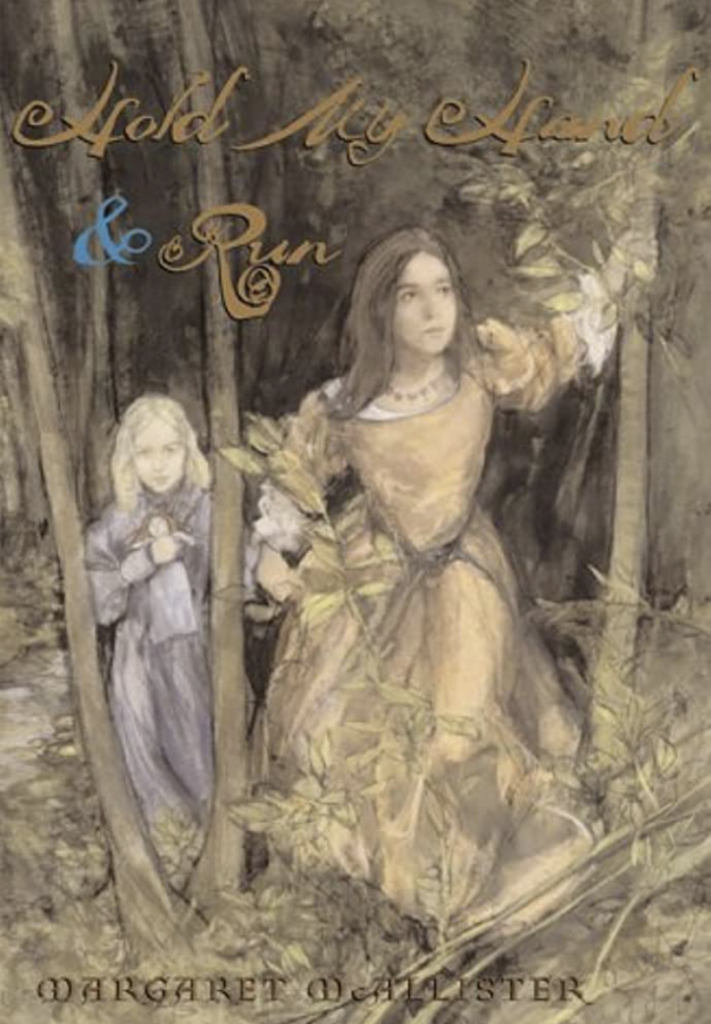I discovered English author Margaret McAllister through her Mistmantle Chronicles books. Those beautiful books have become a favorite series in my home and my lending library. In fact, I love them so much that I named my dog Cedar in honor of one of the characters we meet in book two. I have since read as many of her other books as I can get my hands on here in the United States. While interviewing McAllister last fall, she told me that she thought I would really enjoy and appreciate one of her first novels, Hold My Hand and Run. And . . . she was right.
In our interview, one of the things we talked about was how she presented serious topics to children. She allows our children to wrestle with things that are scary, or maybe a little traumatic, or unsettling. She enables our children to be stretched and to grow, but she never abuses them. She never violates our trust. She calls these storylines “growth rings,” like in a tree. I love that imagery! And I love how much she loves our children. Parents may wish to know that this book, Hold My Hand and Run, offers some growth rings for our children.

I confess: when I saw the cover of this book and read the jacket description, I did not think I would like this book. However, I took her word for it and ordered a copy from the UK since I couldn’t find any here. Once it arrived, however, it took me a while to actually want to read it. Whatever I was expecting, I was wrong. And . . . McAllister was right.
This book deals with a challenging topic: child abuse. Absolutely nothing happens on-scene, and when we enter into the story, the girls are in the act of running away. People with trauma or family wounds in this area may wish to be careful with this one. That said, I do think this book is quite safe for the regular reader. And it’s elegant and beautiful. Setting it in the 17th century probably helps quite a bit. Instead of thinking of a modern child, whom the sad old aunt is abusing, it reads a little bit more like a fairytale – more of a Cinderella story than something you might see on TV as an after-school special.
“There is always love. Always in the tangle, and beyond it.”
Thirteen-year-old Kazy’s father was a good and hardworking clergyman. Her mother died in childbirth, leaving Canon Walter Clare grief-stricken but unwilling to send his daughter to live with relatives. Five years later, when he fell in love with and married a sweet, lively, and good country girl, the family was happy again. They were even happier when Beth was born. Six years later, however, Walter was taken ill after caring for a sick parishioner. Eliza nursed her husband back to health, but in doing so, she contracted a fever and died. Canon Clare’s grief was all-consuming. To help manage the household, Canon Clare’s sister, Frances Latimer moves into the vicarage. Aunt Latimer was a small-minded, exacting, and cruel woman who used a birch rod freely on the children’s arms, backs, and legs for any childish mistakes.
When the story opens, it is very early in the morning, and Kazy is sneaking into Aunt Latimer’s bedroom so she can reclaim her mother’s house keys. The previous day, Aunt Latimer had used her infamous birch rod on both girls liberally, and Kazy could no longer stand to watch her baby sister be hit. Kazy wants to reclaim just a few of her own things Aunt Latimer has locked away, and then she plans to smuggle Beth to the safety of more friendly relatives. It pains Kazy to leave her father, but Canon Clare cannot be shaken out of his grief to see the harm happening to his girls.
Kazy and Beth escape the vicarage and make the arduous trek to Beth’s mother’s country relatives. Along the way, the girls encounter friends and foes. And when they reach Beth’s family, things are quite dire. They have a short respite, but Aunt Latimer is in pursuit, and the girls are forced to flee again. This time, making the much longer and more dangerous flight to Collywell Cross where Beth’s mother was loved.
It is impossible for the girls to get to Collywell Cross easily. They need food, shelter along the way, and help. When the girls reach Abbey St. Andrew, they are starving and exhausted. By luck, they meet their cousin in Abbey St. Andrew, and Will helps them to find a job as housemaids and companions to an older woman who is in mental decline. The work is impossibly hard, but it does mean shelter and food for a time. But, even that takes an unfortunate turn, and the girls are on the road again.
In the end, all turns out very well. Not a sappy ending, but a true one. Love does conquer all. But love demands sacrifice and some suffering. The story is beautifully told and quite unlike most other stories offered to our young people. If this were not out of print (and hard to find in the U.S.), I would clamor to do it as a book club with my library patrons.
Typical of McAllister’s writing, the language is elegant and powerful. The story is deep, interesting, and authentic. No abuse happens on-scene in this story, and when it is referenced, it is done in a way that does not harm our children. Young readers are in very safe hands with Margaret McAllister! And, I was relieved to find a prettier cover…
